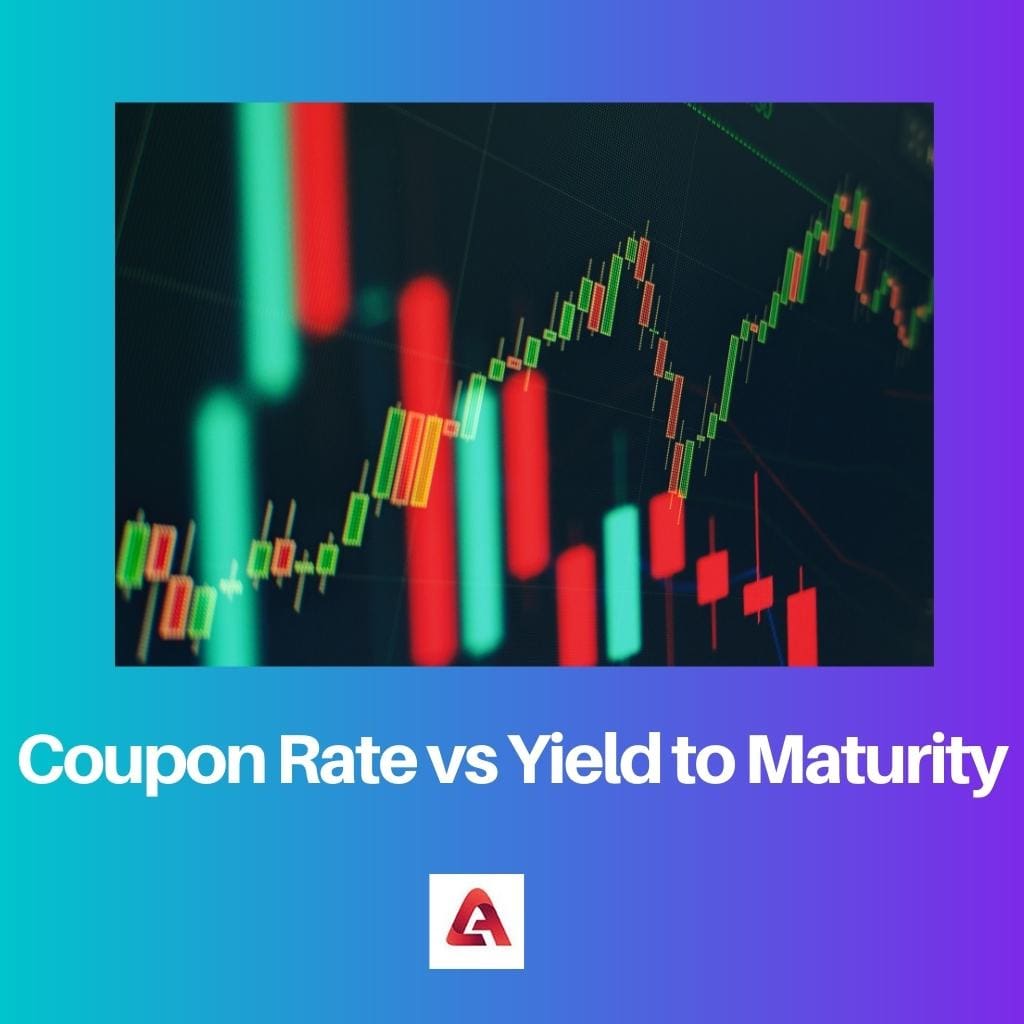As our elders say, “Savings is the key to living secure life,” Everyone should save money and resources for future generations and secure the bank balance for an upcoming emergency.
Investments are one of the methods to safeguard and protect hard-earned money to be further used in a crisis.
Therefore, while making investments, everyone comes across many terminologies they do not know about and cannot distinguish between them; thus, Coupon Rate and Yield to Maturity (YTM) are two.
Key Takeaways
- Coupon rate refers to the fixed interest rate that a bond issuer pays its bondholders, expressed as a percentage of the face value of the bond.
- On the other hand, yield to maturity is the total return anticipated on a bond if it is held until its maturity date.
- The primary difference between coupon rate and yield to maturity is that coupon rate is fixed, while yield to maturity fluctuates based on the bond’s market value.
Coupon Rate vs Yield to Maturity
The Coupon Rate is the annual interest rate that a bond pays its holder, expressed as a percentage of its face value. It is a fixed rate that does not change over the bond’s life and represents a constant income stream for the bondholder. Yield to Maturity (YTM) is the total return expected on a bond if the investor holds it until maturity, including the coupon payments and the difference between the purchase price and face value.

The Coupon Rate is the same throughout the bond tenure year. Also, it is sometimes known as “Bond Yield” to make the terms a little bit complicated. The Coupon Rate represents the annual interest a person is going to receive.
It is calculated manually based on the face value, not the market price.
Yield to Maturity (YTM) can be defined as those bonds an individual receives after the bond maturation date. The value of mature bonds is said to be higher. It can be calculated with the help of financial calculators, which are now available on the internet.
Also known as “Book Yield” or Redemption Yield.
Comparison Table
| Parameters of Comparison | Coupon Rate | Yield to Maturity |
|---|---|---|
| Definition | It is the amount paid by the bond issuer on the face value. | It is the amount of money the bond issuer gets after his/her maturation of the bond. |
| Formula | Annual Payment/Face Value × 100 | {CP+(FV-PP/n)}/{FV+PP/2} |
| Rate | It remains the same for the entire year. | It changes depending on the current market price and the time remaining for the maturation of the bond. |
| What it represents? | It represents the annual interest payment rates that the bond issuer will receive. | It represents the average return received by the issuer. |
| Also Known As | Bond Yield | Redemption Yield or Book Yield |
What is Coupon Rate?
The coupon Rate is the fixed rate the person will pay on the face value. It is somewhat like fixed-income security for government or corporate bonds and is also known as “Yield from the Bond.” This term is sometimes used to make the topic more complicated.
The coupon rate represents the annual interest payments that the bond issuer will receive.
The coupon rate can be measured with a simple mathematical formula by dividing the annual payment by the face value of the bond multiplied by 100. This formula can be deduced as follows:
Coupon Rate = Annual Payment / Face Value × 100
Face value is used to define the maturity value of bonds and the dollar value of the coupon. The bond’s market value can fluctuate, i.e., higher or lower. It also depends on the interest rate and the current credit status of the bond.

What is Yield to Maturity?
Yield to Maturity (YTM) is defined as the individual receiving the total amount of money after the maturation of their bonds. Yield to Maturity (YTM) bonds are considered to be long-term. Also known as “Redemption Yield” and “Book Yield.”
The most significant assumption related to Yield to Maturity (YTM) is that it was invested for half a year and should reinvest within the same if you save money.
The term can be compared to the current market yield as it helps to measure the cash inflows of a particular bond at the current market value and tells the individual how much they can invest and make a profit out of it.
Yield to Maturity (YTM) can be calculated as follows:
Yield to Maturity (YTM) = {CP+(FV-PP/n)}/{FV+PP/2}
The above abbreviations are used for the following terms –
CP = Coupon Payment
FV = Face Value
PP = Purchase Price
n = Year left till Maturation Period

Main Differences Between Coupon Rate and Yield to Maturity
- A coupon rate can be the money a bond issuer has to pay relative to its value. At the same time, Yield to Maturity (YTM) can be defined as the total amount of money accepted by an individual after maturation.
- The coupon rate is also known as “Yield from the Bond.” This term is used to complicate things at some point, while Yield to Maturity (YTM) is also known as “Redemption Yield” and “Book Yield.”
- The coupon rate remains the same throughout the bond tenure year, while Yield to Maturity (YTM) changes with the period left for the bond maturation and also on the current market value of the bond.
- The coupon rate represents the interest payment rates that are to be received annually by the bond receiver. In contrast, Yield to Maturity (YTM) represents the average return received by the bond issuer.
- The coupon rate tells you about when the bond was paid when it was issued, while Yield to Maturity (YTM) tells you how much will be delivered in the future.




